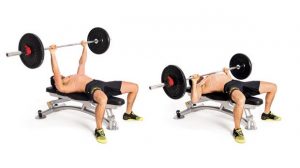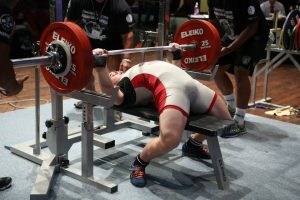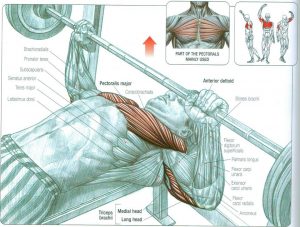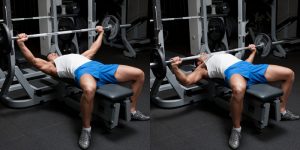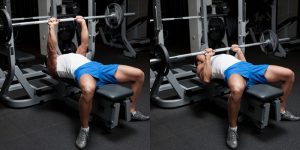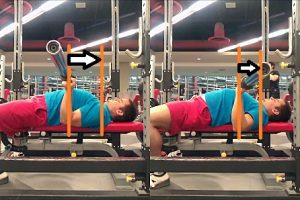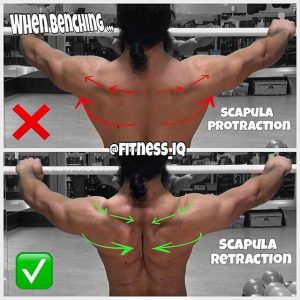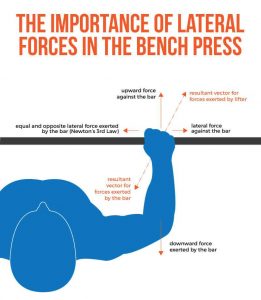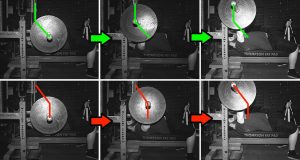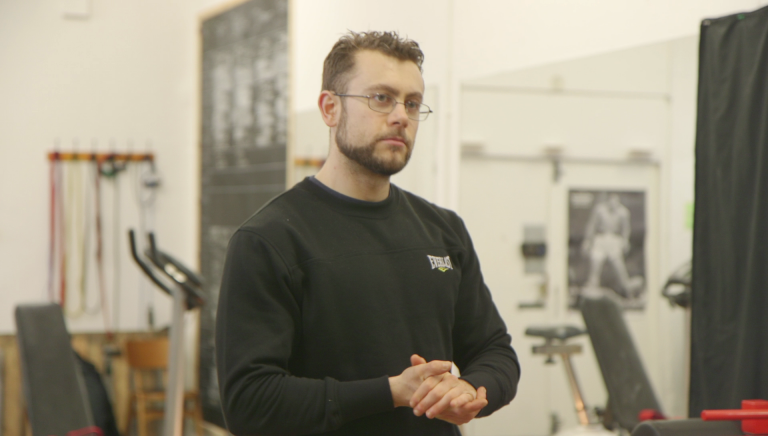The Bench Press; A Bio-Mechanical Assessment

Introduction
The bench press is of course one of the three powerlifts, and is performed to a set of strict rules. In contrast to the squat, the bench press is not performed (with as much purpose) by weightlifters. Weightlifters may bench press as part of their training, but due to the plain of movement it is not useful to them. Due to this, this article will compare the ‘recreational’ style bench press, and the ‘powerlifter’ style bench press.
Recreational Style Bench Press
This article will provide an overview of the movement requirements and recommendations for the average fitness enthusiast to maximise safety and performance, as well as the bio-mechanical / technique differences that allow powerlifters to move more weight.
Powerlifting Style Bench Press
The bench press is often used as a measuring stick for evaluating upper body strength (Robbins 2012; Bianco, Paoli & Palma 2014), and there is ample evidence describing its use for improving upper body muscular endurance, strength, hypertrophy (muscle size) and power (Buitrago et al., 2013; Ogasawara et al., 2012; Schoenfeld et al., 2014).
Walk into any gym in the country and before long you will hear the question “How much do you bench?”.
There are some variations of the bench press exercise including the close-grip bench press, wide-grip bench press, incline bench press, decline bench press, dumbbell chest press, and reverse-grip bench press, some of which we will look at later.
The primary joint actions that occur during the bench press include:
Eccentric (lowering) Phase, Horizontal shoulder abduction, Elbow flexion, Concentric (lifting) Phase, Horizontal shoulder adduction, Elbow extension.
The nervous system activates muscles in groups rather than in isolation, many muscles are involved in the joint actions listed above. It is also important to note that muscle activation varies depending if the muscle is performing an eccentric muscle action or a concentric muscle contraction, as well as the technique selected by the lifter (i.e., wide grip versus narrow grip).
Basic Technique / Position
Lie on a bench with feet flat on the floor. Maintain a 5-point contact position in which the following body parts remain in contact with the bench or floor: (1) back of head, (2) shoulder blades/upper thoracic region, (3) gluteals, (4) left foot, and (5) right foot. These five points of contact are the same whether being performed by recreational or competitive powerlifters (although powerlifting federations differ on how much of the foot is allowed to be on/off the floor).
Some individuals shorter in stature or mobility issues may not be able to place their feet flat on the floor. In this case, an elevated surface such as weight plates or short steps are used as foot rests near the end of the bench. With enough ankle / hip / back flexibility though this would enable a large ‘arch’ to be used.
Grasp the barbell with an opposing thumb grip (thumbs wrapped around the bar) with your hands shoulder-width or slightly wider than shoulder-width apart. Grip width can be altered and used to a lifters advantage, particularly in powerlifting to decrease range of movement (ROM) – this will be covered in more detail later.
Grasp the bar with the wrists positioned directly under the bar. This position helps avoid hyperextension of the wrists. This will also provide more direct power transfer, again covered later.
Keep the scapula back and down. Retracting the scapula during the bench press 1. Forms a more stable base of support against the bench, 2. Decreases anterior forces through the shoulder in the lower position, and 3. Optimises the mechanics of the Pectoralis major.
The Pectoralis Major essentially has characteristics of a bi-articulate muscle, practically crossing the shoulder girdle and shoulder articulations simultaneously.
By maintaining scapula retraction as the bar reaches its lowest position, the Pectoralis Major enters into a stretch reflex cycle sooner without the elbows traveling as far back behind the shoulders. This is because the Pectoralis Major enters into Passive Insufficiency sooner with the shoulder girdle retracted as opposed to scapular tilting forward (Protraction with anterior tilt).
Keeping the shoulder girdle retracted near the top of the lift keeps the Pectoralis Major from entering Active Insufficiency as they continue to contract. Although the Pectoralis Major is primarily engaged at the lower portions of the lift, they appear to also assist the Triceps and Anterior Deltoids throughout the mid and upper ranges as seen by EMG activity (Duffy 2008).
Breathing Pattern
Elite athletes or powerlifters may perform the Valsalva manoeuvre during the bench press. The Valsalva manoeuvre requires a bracing technique in which a person exhales through a closed glottis (airway). It’s a technique used to increase intra-abdominal pressure and may enable a person to lift heavier loads with experience. However, this technique is not advised for anyone who is new to exercise or has high blood pressure. It also increases the risk for dizziness and loss of balance. A good coach will be able to advise on the use and technique of this.
Some lifters will use a weight belt to try and maximise this technique, however it can impact on the arch position. More on the arch later.
Musculature
Musculature of the Bench Press
The Pectoralis Major is the primary muscle used in the Bench Press. Both the Sternal and Clavicular heads of the Pectoralis Major transversely flex the shoulders during the bench press (Lauver 2015, Duffey 2008). Pectoralis are utilised the greatest in the lower portion of the decent phase and the early portion of the lifting phase. Peak activity in the lift phase occurs early (35% lift time). (Duffey 2008).
The Anterior Deltoid assist in transverse flexion of the shoulders as well as flexion of the shoulders, particularly when the upper arms are closer the sides of the body. The Anterior Deltoids are utilised the greatest in the mid position in both the descent and lifting phases (Duffey 2008).
Triceps, particularly the lateral and medial heads extend the elbow during the Bench Press. They are utilised the greatest in the lifting phase as compared to the lowering phase. Like the Pectoralis Major, maximal activity of the triceps actually occur late in the descent phase and early in the lift phase. Their involvement also peaks again near the top of the lifting phase, particularly with a narrower grip. (Duffey 2008)
Grip Position / Width
There are variations in elbow position an individual can use when performing the barbell bench press. Some people preach a position in which the upper arms and elbows “flare out” away from the torso. Other experts recommend a position in which the elbows are close to the body, especially for those who have a history of shoulder pain or injury.
Wider grips increase pectoralis major sternocostal head activity. Narrower grips widths of between 100% and 200% of shoulder width may enhance pectoralis major clavicular head activity, Lehman et al. (2005), Barnett et al. (1995), Clemons et al. (1997).
Bench press lifting performance increases as grip width is increased up to approximately twice the biacromial width (shoulder width as defined by the distance between acromion processes) performance (Madsen 1984, Wagner 1992, Clemens 1997, Gilbert 2003). Barnett (1995) reported a approximately 5% greater resistance can be lifted in a wide grip smith bench press versus a narrow grip smith press, however this difference was calculated to be statistically insignificant. However Wagner (1992) showed that the greatest single 1-rep bench press performance was achieved with a relatively wide 200% biacromial width, a 7% greater load compared to narrow grip beech press performance.
Elbows Out / Wide Grip
It has been shown in the literature that performing the bench press with the elbows flared out to the sides and/or using a wide grip is best for activating the pectoralis muscles, particularly the sternoclavicular portion of the pectoralis major, the largest portion of the chest (Lehman, 2015).
However, this position may place the shoulder in a vulnerable position (Green, 2007). If a person has a history of shoulder impairment or displays limited range of motion through the upper extremities, it will be best to perform the bench press exercise with relatively light loads with an elbow-in position, or avoid altogether until shoulder stability and mobility impairments are corrected (Fees et al., 1998).
In this wide grip position, as you can see from the picture, it enables the lower arms / wrists & elbows to stay closer to the vertical bar path. This reduces the moment arm, and therefore makes the lift bio-mechanically stronger.
A wider grip width on the bar both decreases the range of motion of the lift and the final height of the bar. These factors could be possible explanations for increased bench press performance with an increased grip width (Madsen 1984, McLaughlin 1985). The bar travels nearly 25% further with a shoulder width grip (biacromial width) as compared to a grip twice the width. The increase in lift height results in 20° greater shoulder flexion and 25° greater elbow extension. The forearms are also angled out further with a wider grip (Duffey 2008).
Elbows In / Narrow Grip
In contrast, a position with the elbows closer to the torso and/or using a slightly narrower grip places a greater emphasis on the anterior deltoids, clavicular head of the pectoralis major (upper pectorals), and triceps brachii, and less activation of the sternoclavicular portion of the pectoralis major (Lehman, 2005; Clemens & Aaron, 1997). In addition, this position may be less aggravating for people with a history of shoulder pain because the eccentric phase requires less shoulder horizontal abduction and places a greater emphasis on sagittal plane shoulder extension.
However, it is important to note, this position generally limits the amount of load a person can lift. The motion limits activation of the powerful sternoclavicular portion of the pectoralis muscle. Instead emphasis is placed on the smaller muscles (triceps brachii, anterior deltoid, upper pectorals) and as a result may not be ideal to develop maximal strength or muscular size.
As you can see from the picture below, with a narrower grip the elbows upper arms / wrists are forced forwards to stay directly under the bar, thus increasing the horizontal distance the bar has to travel, and therefore the moment arm.
Grip width and ROM both affect peak elbow flexion angles. Elbow angles are more acute when performing the narrow grip and full ROM bench press. Grip width affects peak shoulder abduction angles. Shoulder abduction angles are more acute in the narrow grip bench press.
A side on view of the difference in moment arms in the narrow grip, and wide grip bench press respectively
A quick recap on moment arms, in case the previous article was not read;
“Moment(s) / Moment Arms
Moments are also known as “moments of force”, “turning forces” or torque. They can be thought of as forces applied in a rotational system, horizontally & vertically. Moments are vectors and therefore have both a direction and a magnitude.
The magnitude of a moment is dependent not only upon the size of the perpendicular force exerted but also upon its distance from the pivot, which is called the moment arm length.
Practical Perspective
Net joint moments are produced by the balance of agonist and antagonist muscle forces, and their associated internal moment arm lengths. They are exerted in order to overcome an external load and its associated external moment arm length, which produces a requirement for an internal net joint moment. Many exercises have a particular point in the range of motion that is harder than the rest of the movement. In most cases, this is caused by differences in external moment arm lengths. However, changes in internal moment arm lengths can also lead to differences in the necessary muscle force at different joint angles. Understanding how both external and internal moment arm lengths change during an exercise is therefore helpful for appreciating its effects on the requirement for muscle force at a specific joint angle.
Joint moments that we measure are the net effect of the positive agonist muscle forces and associated moment arm lengths and the negative antagonist muscle forces and their associated moment arm lengths. They are therefore more properly called net joint moments.”
Scapular Retraction
Scapular retraction during the bench press is important to maximise safety and performance. This position creates a stable base of support against the bench for the shoulders, decreases anterior forces through the shoulder complex particularly during the eccentric phase, and may improve activation of the pectoralis muscles (Duffey, 2008; Bench Press Analysis). Many argue this is the safest position for the shoulder complex, especially during heavy lifts because it provides added stability for the shoulders.
When performing a bench press with a retracted scapula, some argue the pectoralis muscles enter the stretch reflex position sooner during the eccentric phase. By harnessing the stretch reflex, individuals will be able to maximise muscle recruitment during the concentric phase of the lift and subsequently the ability to lift heavier loads. Note, this will be markedly less during a ‘paused’ bench press.
Wilson (1991) found that the effect of the stretch-shortening cycle in the bench press diminishes rapidly with time, with a half-life of 0.85 seconds. After a pause of 1.5 seconds between the eccentric and concentric phases, 30% of the performance augmentation remains in effect. Similarly, after a shorter pause duration of 0.35 seconds, 75% of the performance augmentation remains in effect. A pause of 4 seconds between the concentric and eccentric phase would be required in order to avoid any performance enhancement from the stretch-shortening cycle. (Wilson 1991)
Scapular retraction also limits protraction and anterior tilting of scapulae (rounding the shoulders forward) during the exercise (Duffey, 2008). This would also place the muscles in a bio-mechanically stronger position (see stretch reflex reference, above).
In one study assessing the effect of bench press technique, Jagessar (thesis) found no difference in pectoralis major muscle activity between an “elbows out” (90 degree abduction) and a “tucked powerlifting-style elbows” (70 degrees abduction) shoulder position. Similarly, Jagessar (thesis) reported no difference in pectoralis major muscle activity between a neutral and retracted scapular position, and between arched, neutral and flat lower back positioning. However, it is important to note that the effect of technique has only been reported in recreationally trained males and not in trained powerlifters.
Sticking Point
The sticking point [usually] occurs shortly after the initiation of the concentric phase of the lift, typically when the bar is 3-16 cm from the chest (Van den Tilaar & Ettema, 2013). The sticking point is not the same location for everyone yet researchers have concluded it usually takes place about 0.2 seconds after the initial upward movement, and lasts about 0.9 seconds (Van den Tilaar & Ettema, 2013). It is unclear whether this was during a regular bench press, or powerlifting style.
Some researchers found the reason for the sticking point may be a loss of elastic energy from the stretch reflex discussed previously (Elliot, Wilson & Kerr, 1989). Because the elastic assistance of the stretch reflex ends very quickly, it creates added burden for the prime movers to move the weight.
However, some researchers identified that muscle activity significantly changes during the sticking region when compared to the pre-sticking and post-sticking periods. This may be due to a mechanical disadvantage because the elbows tend to move more laterally through the sticking point (Gomo & Van den Tilaar, 2015), or changes to joint angles and moment arms.
In the sticking region, grip width affects elbow flexion and shoulder abduction angles. Elbow angles are more acute in the sticking region when using medium and wide grip widths. Shoulder abduction angle is more acute at the start of the sticking region when using a narrow grip width.
Gomo & van den Tillaar (2015) examined how three different grip widths affect the sticking region in powerlifters’ bench press performance. Twelve male experienced powerlifters (age 27.7 ± 8.8 years, mass 91.9 ± 15.4 kg) were tested in one repetition maximum bench press with a narrow, medium and wide grip. The sticking region did not occur at the same joint angles in all three grip widths. This disproved the theory that the sticking region would occur at the same joint angle of the elbow and shoulder independent of grip width.
In successful 1RM attempts, the elbow external moment arm length reduces in the sticking region compared to unsuccessful 1RM attempts, likely due to the initial vertical displacement of the bar.
Force & Power Output
Higher training status, using accommodating resistance in the form of chains, overloading the eccentric action, utilising a partial ROM, and lifting with a hand grip between 165 – 200% of bi-acromial width are all associated with greater 1RM bench presses.
Greater relative loads and performing the bench press with maximal concentric velocity are associated with greater peak force output. Longer rest intervals, a heavier load prior to the set, and an ascending loading scheme are associated with greater power outputs. Peak power appears to occur between 45 – 55% of 1RM. Interestingly, the relative load that maximizes peak power is lower in stronger than in weaker athletes.
Effect of Bench Press Angle / Arch
For general strength training, the lower back forms a natural arch when the head, upper back, and hips are in contact with the bench. Placing the feet apart on the floor creates a more stable base of support.
However, in powerlifting, the spine is placed in a hyperextended arched position with the hips making contact with the bench throughout the lift. To facilitate hyperextension through both the thoracic and lumbar spine, the feet are tucked back so forefeet remain on floor. Once the weight is set, heals are pushed onto floor. (Kovacs 2014). Note that in some federations, mainly the IPF, the feet (including heel) must remain on the floor throughout the lift.
Assessing four different bench angles, Barnett et al. (1995) found greater pectoralis major sternocostal muscle activity when using an incline bench of 0 (i.e. flat) and -18 degrees (i.e. decline) than with an incline of 40 and 90 degrees, with a narrow grip. In contrast, with a wide grip, they found greater levels of pectoralis major sternocostal muscle activity with an incline of 0 degrees (flat) compared with the other inclines. Similarly, Trebs et al. (2010) found a superior level of pectoralis major sternocostal muscle activity at 0 degrees (i.e. flat) compared with inclines of 28, 44 and 56 degrees.
Lauver et al. (2015) compared -15, 0, 30 and 45 degrees and found that the decline and flat angles produced superior pectoralis major sternocostal muscle activity. Finally, Glass & Armstrong (1997) found significantly greater sternocostal head muscle activity when performing the decline bench press compared to the incline variation.
All of these studies show that greater pectoralis major sternocostal head muscle activity is displayed with bench angles between -18 and 0 degrees compared with bench presses using inclined bench angles.
Arching the spine places the rib cage higher so the bar does not have to be lowered as far down before it makes contact with the lower chest. In addition, it also declines the torso so the Pectoralis can push the bar upward in a stronger plane of movement: shoulder transverse flexion with slight shoulder adduction. This plan of motion is more similar to the Decline Bench Press. In an extreme arched position, the Latissimus Dorsi assists by shoulder adduction.
Upper Arm Positioning
Some individuals may be able to perform bench press with the upper arm portioned further out without issues due to individual structural differences (Contreras 2011). However, performing bench press with the upper arms positioned close to 90° to the torso is thought to place the shoulder in a potentially vulnerable position, at least for some individuals, particularly when combined with other Weight Training Injury Risk Factors (Green 2007).
In contrast, positioning the upper arms closer to the body in the lower position is thought to increase the load on the Anterior Deltoid, clavicular head of the Pectoralis Major, and Triceps while decreasing involvement of the sternal head of the Pectoralis Major. In this close arm position, the shoulder may have greater mobility with less potential shoulder issues. However, this totally adducted shoulder positioning can also limit the resistance that can be used since this close arm position limits the involvement of the powerful sternal head of the Pectoralis Major while emphasising the relatively weaker front deltoid, upper chest, and triceps.
Hand spacing of 2 biacromial width increases shoulder abduction above 75°, whereas hand spacing <1.5 biacromial width maintains shoulder abduction below 45° (Fees 1998).
Interestingly, Zatsiorsky and Kraemer (1995), leading academic in the field of weight training recommend the upper arm to form a 65º to 90º angle to the torso in the chest-touch position.
Coach Rippetoe (2015), author of Starting Strength, suggests a 70º upper arm position with the forearms vertical at the lowest bench press position. According to Rippetoe, this width of grip permits the longest range of motion around the shoulder at the bottom of the movement. As the barbell is raised, it is positioned over the shoulders in the path of a “J”. It must be noted however, that this reference may apply to ‘equipped’ bench press (with a bench shirt being worn).
Lower Arm Positioning
Everything again comes back to physics. The bar is a constant downwards force that you want to counteract, so you want your line of drive to be directly into the bar, keeping the forearms facing upwards to give the most efficient transfer of energy. The bar should rest in the pocket between your thumb and your hand, not rested across your finger pads as, when it is rested in here, we have no stabilisation from the thumb. More importantly, the weight is resting off the line of the forearm creating a new, and unnecessary, fulcrum.
Elbow tracking
Unlike the bodybuilding press, the elbows on a powerlifting bench are kept relatively tight to the body (not too tight though), as this is both protective and a stronger position to push from. The more the elbows “flare” in the bench press, the greater the resultant force across the shoulder joint.
Elbow tuck/elbow flare: The force is applied through the elbow. It must stay directly below the bar as you move it to the chest. This requires tucking them in toward your body, which has positive benefits as noted above and also moves the point where force is applied closer to the body. During the press, it is important to flare the elbows as the bar is pushed back to maintain the elbow position directly below the bar. If this isn’t done, an entire new set of equations come into play, with the result being the bar heading back down toward the lifters face. Elbow tuck and flare should be in direct relation to the bar position. The tuck on the way down dictates the bar position while the flare on the press is dictated by the bar position.
Range of Motion
Strength Training performed through a full range of motion has been shown to increase and maintain joint flexibility (Morton 2011, Souza 2013). Shoulder flexibility will likely decrease if shoulders do not travel through full range of motion (until slight stretch or pull is felt through shoulder or chest, while maintaining shoulder retraction) unless specific stretches or movements are performed to supplement program compromised by limited range of motion.
However, those with a thicker rib cage or those performing a powerlifting-style bench press will have less lower range of motion due to the arched back position.
Fees (1998) points out that the narrower 1.5 times biacromial width grip actually increases transverse flexion. This may be true in a flat back bench position, however the arched spine position typically performed by powerlifters can actually decrease range of motion since the bar does not need to be lowered as far with the low chest raised upward.
Elite Lifters
Madsen and McLaughlin (1984) compared the single maximal lifts for world class power lifters to group of recreational lifters. The world class powerlifters moved the bar more slowly throughout the exercise and kept the bar more directly over the shoulder during the lift phase. Lowering the bar more slowly may have reduced the forces required to stop the descent of the bar. This may also have been done to control the paused position of the competition press (not a consideration in recreational lifting.
Wilson (1989) compared a maximal bench press lift with a single sub-maximal bench press lift at 80% of maximum in elite lifters. In addition to differences in vertical acceleration, the elite lifters tended to keep the bar more directly over the shoulder during the lift phase of the maximal load, showing similar form to the elite lifters mentioned in Madsen and McLaughlin (1984) study.
An image showing the correct bar path of elite powerlifters in the bench press
Bench Press Leg Drive
Leg drive is a concept that falls somewhere between set-up and execution. Realistically, leg drive is involved in both phases. If you’re unfamiliar with the concept, leg drive, as it pertains to the bench press, is literally the active engagement of the lower body by pushing the ground with your feet. You “drive” your legs into the ground, hard.
Leg drive can be used in one of two ways. The first method simply helps to take the slack of the system. If you push the ground with your feet, you extend the kinetic chain to the ground. The force transferred from your legs tightens up your entire body and translates to a bigger arch and a higher chest position. As we’ve heard a thousand times already, a tighter set-up means more weight lifted.
Leg drive should begin during the set-up and it should be maintained throughout the entire lift. Just as you don’t let your air out during a big lift, you don’t stop with your leg drive either. Get tight.
The second method of using leg drive involves purposely leaving some slack in the lower body. With this method, the lifter waits until he is given the press command before he initiates his full leg drive. This creates a “jolt” effect that gets the bar started. Talk to your coach to determine which method will work best for you.
Conclusion
The comparison between a recreational and powerlifting bench press show vast differences, maybe more so than the comparison between a weightlifting and powerlifting squat. The aims are very different (muscular hypertrophy, aesthetics, sports / everyday life performance compared to strength increase power output, weight lifted etc.).
While bodybuilders / recreational lifters may want their muscles to be ‘felt’ working, powerlifters generally try to move the weight by manipulating joint positions and maximising bio-mechanical advantages – reducing moment arms, and keeping the weight close to the fulcrum.
Some of the techniques cross over and should be used by both groups, to a certain extent (scapula retraction, leg drive). Others should be more focused (arch, grip width, elbow tuck). Either way, it is important that a qualified, experienced coach guides you, even more so with the powerlifting style bench press.
To finish, here’s Jennifer Thompson bench pressing 325lbs (147.5kg) with minimal set up after giving a talk to an American Football team:
https://www.youtube.com/watch?v=ScuC2DrBRus
References
http://www.ptonthenet.com/articles/biomechanics-of-the-bench-press-4019
https://www.strengthandconditioningresearch.com/exercises/bench-press/
http://www.exrx.net/Kinesiology/BenchPress.html
http://www.powerliftingtowin.com/powerlifting-technique-how-to-bench-press/
https://etda.libraries.psu.edu/catalog/8894
http://journals.humankinetics.com/doi/abs/10.1123/ijsb.5.4.390
http://journals.humankinetics.com/doi/abs/10.1123/ijsb.8.1.1
http://www.musclepalace.com/search/label/build%20muscle%20mass
http://www.coachmag.co.uk/exercises/chest-exercises/186/bench-press-technique-tips
http://www.bmtrainers.it/bench-press-form/
https://www.strongerbyscience.com/how-to-bench/
http://weighttrainingexercises4you.com/wide-grip-barbell-bench-press/
https://stronglifts.com/bench-press/

